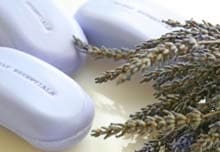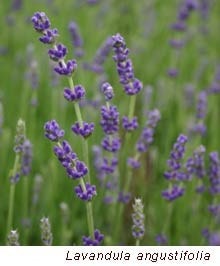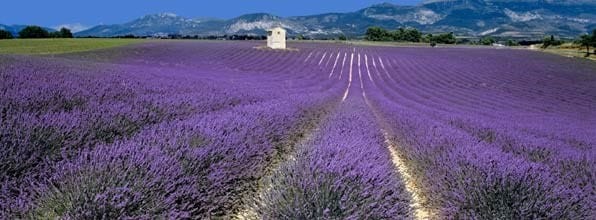Lavender

Lavenders are perhaps one of the best known and most loved plants in our gardens. These aromatic, evergreen shrubs are mainly native to the Mediterranean and have been in cultivation from the middle of the 16th century - used since that time for both ornamental and medicinal use. Today, they are grown for their soft grey-green foliage and long-stemmed spikes of fragrant flowers, which appear from mid- to late summer. The flowers generally have a very high oil and nectar content which bees love, so they are a great addition if you want to attract wildlife to your garden. They are perhaps one of the most highly prized of all the aromatic shrubs, because their foliage not only provides subtle grey accent in decorative borders, but they are suitable for so many different locations in the garden. They are equally at home in shrub borders, rock gardens, containers, or as informal hedging. They form a billowy edging as they tumble out over pathways and lawns where their delicious scent will escape as you brush past them. They grow happily alongside most plants, and are also useful because they have pest-repellent properties.
Herbal uses

The therapeutic properties of lavender have been well known for centuries. Before soap was discovered people used to wash with lavender water, and scatter the flowers on the floor to make rooms smell sweeter. The flowering stems were picked when they began to bloom and then dried in small bunches, or the flowers were removed from the stems and dried – a practice that is still carried out today. Lavender bags, pot pourris and pomanders became popular, and are still widely used in linen cupboards and chests. Not only does it make your clothes smell nice, but it also has the added benefit of keeping moths at bay. Today, lavender is largely used in the perfume industry, where the plant is cultivated on a large scale for adding to soaps and other cosmetic products. Lavender oil in the bath smells nice, but is also very soothing, helping you to relax.
In France, lavender is often added to casseroles and fish dishes, but it does have quite a bitter taste. Lavender is also a useful insect pest repellent in the garden when it is planted amid a mixed border, to ward off whitefly and aphids.
Variety guide

There are around 25 different species of lavender in cultivation, with blue, purple, pink or white flowers. The English and Dutch lavenders are hardy while the French types are slightly tender and will need protection in winter, especially in colder areas.
Lavandula angustifolia
– (English lavender) is perhaps the best known. It is has a compact, bushy shape with grey-green leaves and will grow up to 1m high. The powdery blue flowers appear in dense spikes during mid- to late summer, and have perhaps the strongest scent of all the lavenders.
'Hidcote'
is one of the most popular varieties of all because it provides a striking contrast between the deep purple flowers and silvery foliage. It is a smaller plant though (60cm) and the flowers are not as scented.
'Munstead'(and other good blue forms)
is another compact variety (45cm) with loose spikes of strong blue flowers fading once they’ve opened, while Little Lady (40cm) is very free-flowering and has sage green leaves. Blue Ice (50cm) is a relatively new form and as the name suggests the flowers are an ice blue shade.
Pink and White
the best pink flowers can be found in 'Rosea' (75cm), which bears pale rose-pink flowers, while 'Arctic Snow'(50cm) has densely packed spike of pure white flowers.
Lavandula x intermedia
is the Dutch form and is a robust, rounded shrub with broad, almost spoon-shaped leaves. The aromatic foliage is grey in colour and covered in fine silvery hairs. It is smothered in light blue to violet flowers in summer carried on long spikes. A good variety to watch out for is ‘Grosso’.
Lavandula stoechas
and their forms (French lavender) tend to be compact and bushy. They produce short dense spikes up to 3cm long which are topped with conspicuous bracts (a bit like a quiff) during late spring and summer. They are intensely fragrant, but will require a warmer position as they are tender.
Growing guide

Anyone who has visited France during early summer, have seen the rows and rows of lavenders growing amidst the French countryside, covering the hills in a purple haze. These are the types of conditions in which lavenders thrive and we need to try and replicate in the garden. They like dry, sunny, exposed positions with moderately fertile, but well-drained soil. They are also well-suited to coastal regions, but are generally not long lived so need to be replaced after about ten years, since they become woody and unattractive, even if regularly trimmed. In cold areas, the more tender varieties should be grown in pots, because they will need to be over-wintered in a cool greenhouse, but in milder areas they should be fine at the base of a sunny wall. For tender types free-draining soil is vitally important or they will die in the cold winters.
All lavenders should be pruned immediately after flowering to make sure they keep a dense compact shape. To do this, cut back flowered shoots to within 1.5-2.5cm of previous year's growth, but be careful not to cut down into the woody stems which don't have any foliage as they wont re-grow.
Propagation
Seeds can be sown in a coldframe in spring, but some lavenders either don't produce seed or don't come true to type, so cuttings are the best option. Take softwood cuttings in late spring and semi-ripe cuttings in late summer from young plants. Trim below a leaf joint and remove the bottom 3cm of foliage. Dip into hormone rooting powder and grow on in a free-draining compost. Rooting takes 4 – 8 weeks. Lavenders can also be struck from ripewood cuttings taken during early autumn and grown on outside, but these can take up to three months to root.
Pests and diseases
Lavenders are generally trouble free. Here are some of the things to look out for if you want to keep your plants in tip-top condition.

Cuckoo spit
Froghoppers leave unsightly blobs of frothy liquid on the stems in early summer, commonly called cuckoo spit. The pest does little real harm and can be dislodged with a strong burst of water from the hose.

Greymould
This very common disease affects a wide range of plants. Infected areas show a grey or sometimes off-white fuzzy growth. Control is difficult because the fungus is so widespread, but you can spray with a suitable fungicide.

Honey fungus
This is a serious problem which will eventually result in the death of the plant, however keeping them well fed and watered will help build up their resistance.

New beetle pest
There is a new threat to lavenders and this comes in the form of a shiny, metallic beetle called Rosemary beetle, that attacks several aromatic herbs including lavender.










